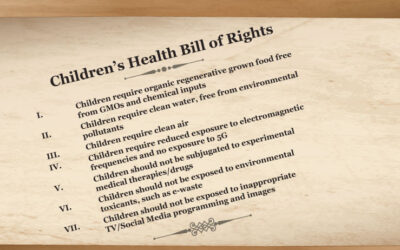There has never been a more important time than the present to understand not only genetically engineered organisms, but the research behind their propagation and promotion. The science of genetically modified organisms (GMOs) or genetic engineering (GE) is rapidly evolving, and their introduction has altered and affects all aspects of our well-being, including:
- Our health and the environment
- Agriculture
- Food manufacturing
- Medical products
New applications of existing tools are constantly being developed, with access by professional and amateur scientists, both in the lab and in home garages. While still novel, claims of precision are unfounded and continue to prompt new questions about the environmental and health impacts.
To say that the understanding of GE technology is clear is arrogant. It is a complex challenge to understand the risks, performance, and costs of new developments, such as CRISPR. Market excitement, accompanied by profitable patents grab supersedes precaution and a thorough understanding of what is at stake is ignored or discarded. The argument of “safety” remains murky in the case of many GE crop technologies.
As physicians, scientists and farmers, we read health-oriented scientific studies every day, looking to gain a deeper understanding of the root causes of dis-ease, while attempting to uncover better ways to restore and preserve health. The content of our website, Regeneration Health International (www.rhi.bio), draws upon not only our boots-on-the-ground experiences, but our collective wisdom in interpreting science and how we help to understand and offer solutions on how to optimize health.
The Scientific Method and How Science Advances
The scientific method involves making a hypothesis and designing a study to test, support or contradict the hypothesis. For example, if a substance is given to test animals in a long-term feeding trial, and we find that their organs such as the liver and kidneys have normal weight and appearance by the end of the study period, all we can say is that under the conditions of this experiment, there was no evidence of an adverse or toxic impact on these vital organs.
However, a study that delves more carefully into liver and kidney function, and not just the appearance, may reach a conflicting conclusion. Therefore, the first step in any quality study is to carefully review research protocols, records, and analytical and statistical methods in order to identify why the study results differ. It usually takes additional studies to further comprehend what happened and why. In some cases, questions linger even after dozens of studies, investments, and time spent in specialized studies. More questions may be raised than answered.
In the case of the rat feeding trial prior to the launch of GMOs, Monsanto studied rats for a 3 month period, fed a GMO diet. A confounding factor not identified was the quality and sourcing of their diet. Abnormalities were found, for example, in blood chemistries. Rather than performing the recommendations noted above, the conclusion in their study was that the findings were “not of clinical significance”. Both scientists and non-scientists would agree that this is faulty logic. Despite this concerning finding, GMOs were released.
The consequence of any study that demonstrates unintended consequences should have been further studies to analyze the problems found and/or to have withdrawn the product completely.
Are Regulators Regulating?
The challenge for policy makers is to specify the rules that govern what happens in the face of uncertain science and potential risks of severity, reach, and longevity.
With advances in analytical technologies and risk assessment tools, we can look at entirely different aspects and interactions between genetics and lifestyles, and between biology and health. These advances should be welcomed and are needed, and will allow public health scientists and regulators to do their jobs and avoid any uninvited surprised following the present rapid approval and release of GE crop and animal technology.
The Nuts and Bolts of Sound Risk Assessment
The top-shelf type of an experiment is a double-blind, placebo-controlled study in a well-characterized human population. For example, if RHI wanted to assess the safety of a GE corn trait to be introduced into the market, the collective team would need to do the following:
- Assess a large number of people which gives the study “power”
- The people would be separated randomly into two groups
- A specific strain of GE corn grown under typical conditions would be studied
- One group of individuals in the study would consume a defined amount of the GE corn over a specified time period
- The other group would consume the same amount of corn, but from ears harvested from a field planted with the GE corn’s isoline, meaning the same background genetics, but without GE traits
- The control group would be comprised of corn uncontaminated with pesticides
- The two groups would be blinded as to which group they were enrolled and what they were consuming
- The teams conducting the trials would also be blinded as to which individuals were in the two assigned groups
- The team would designate which types of impacts from the ingestion of the corn that warrant tracking and perform comparisons between the groups
- Sample parameters might include changes in weight, metabolism, blood pressure, issues in the gastrointestinal tract, etc.
- Different tests could be utilized to look at organ function, changes in physiology and biopsies, or special tests (I.e., to assess the microbiome)
- When including laboratory tests, before and after studies are desirable for comparison
One of the most important aspects of a study is to avoid bias. Researchers on the teams examining any data or lab samples need to be unaware of which group the samples came from, and this is the second blinded aspect of a double-blind, placebo-controlled study.
The team would then analyze the data and perform the following:
- Compare impacts in the two study groups
- Assess treatment-oriented differences
- Record all findings which may or may not go against what they originally thought the results might reveal.
Human feeding studies are difficult, but are the gold standard. Straying from diet protocols dilutes what is called the statistical power of the study (I.e., the ability to detect differences in outcomes, if they indeed exist). For the best quality outcome, if one is doing a GE corn consumption study, the following would be need to be done:
- The setting is controlled, meaning in this case, the food is provided
- Intake is controlled and carefully measured
- Blinded researchers would be responsible for data collection during the study
- Study supervisors would require technical training
It is obvious the inherent difficulties and expenses one would encounter in trying to create they type of study needed to assess GE products. While the above type of study is desired as outlined-above, such studies have not been conducted on GE crop traits because who will be willing to pay for them? Without this evidence, assertions that foods derived from GE crops are safe are premature and inherently faulty. We have relied on rodent studies with many study shenanigans at play that manipulate data, such as using only a certain healthy population (i.e., juveniles), shortening the course of a feeding study, using contaminated feed in both groups which would diminish the impact of the findings and dismissing abnormal results, and the conflagration of absolute and relative risks. Sound familiar?
What Does Top-Tier Journalism Look Like?
Debate and re-examination of assumptions and accepted conclusions should be ongoing and active. Critical analysis of research methods is essential. However, even study types that appear powerful or invincible can have drawbacks, such as studies called meta-analyses which employ a statistical technique for aggregating data from multiple studies on a topic of interest. These types of studies are very important in healthcare settings because of their ability to weigh in on various degrees of evidence supporting different health strategies.
Conflicts of Interest
The more comprehensive the research the more expenses incurred. Bias can find its way into studies through many avenues, both inadvertent and intentional. That is why all reputable, high-impact journals utilize rigorous peer review and have conflict-of-interest as well as funding disclosure requirements. These mechanisms can serve to promote transparency and alert both study reviewers and readers to be on the lookout for the “devil in the details”.
While journals make efforts to combat bias and to disclose conflicts of interests, this does not make up for the lack of sufficient quality studies presently on GE crops. Often, the companies promoting the engineered foods are in charge of their own studies, injecting immediate bias. Neither the EPA nor FDA independently carry out risk assessment studies.
Teams of independent technology developers are necessary and industry-sponsored studies should be eliminated. The quality of studies conducted by GE technology developers has been uneven, with evidence of inappropriate methods, problematic data collection and fraud. A study is 2 to 5 times more likely to be favorable to a funder with a vested interest in a particular outcome, compared to a similar study on the same subject funded by a neutral source. Over time, the steady pressure of conflicts of interest has done much to skew the focus and quality of science supporting regulatory and public health decision-making, but this is far from what is should be for novel food products. Once they are released into the environment, recall is impossible.
RHI recognized that the restoration of integrity in the assessment and regulation of agricultural biotechnology is a complex and difficult mission, but vital if we are to prevent unintended consequences. Understanding study basics is a key part of this recognition. Our intention is to promote solutions-based platforms to regenerate health.
First, Do No Harm – Primum Non Nocere
An endeared principle to physicians is, “First, do no harm”. Thus, when doctors read scientific studies, they look hard for evidence of potential harm.
If a study does point to possible harm, obvious next questions include:
- Was there a follow up study that looked at the issues
- Did that study resolve or reinforce concerns over risk
- Is there any biological plausibility to a link between certain health problems and the consumption of GE foods and/or their pesticide components
- Can doctors extract from the published literature insights regarding who might be at risk (population cohorts) or who might be most responsive to an intervention
In order to be recommended by a physician, a substance must demonstrate evidence of benefit that clearly outweighs its potential for harm.
While we are presently referring to an invented GE study, one can extrapolate how this type of analysis is relevant to any population threat.
When less harmful alternatives with similar benefits exist, the choice is simple. This should be the basis of all FDA new drug approvals, but is rarely discussed in the context of GE crops and its oversight agency, the EPA. Whether the regulatory agencies are adhering to their own protocols is questionable.
Pressing Recognition of the Need for Excellent, Non-compromised Science
Different global agencies and medical institutions have stated that there are inadequate studies that show that GE foods are unequivocally safe. The scope and kind of studies necessary to support definitive safety findings are not required by the FDA or the EPA and have not been conducted on a single GE trait or crop. The GE plant-based Impossible Burger, now being consumed across the world especially in vegetarian communities, is based on one faulty study showing harm to the scanty number of rats studied, dismissed as inconsequential. We deserve and must demand better. Understanding the science is a key component in determining food policy. The goal of the RHI team is to provide readers, eaters and policy makers regarding what good science tastes like.
This study was originally published by GMOScience, a website with the guiding principle of ensuring that GE crops “does no harm” to people and the health of the environment.



